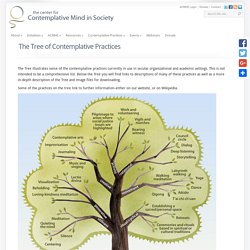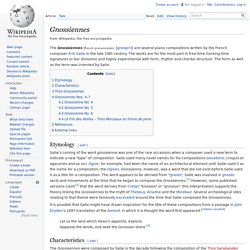

Social Networking in the 1600s. The Tree of Contemplative Practices. The Tree illustrates some of the contemplative practices currently in use in secular organizational and academic settings.

This is not intended to be a comprehensive list. Below the Tree you will find links to descriptions of many of these practices as well as a more in-depth description of the Tree and image files for downloading. Some of the practices on the tree link to further information–either on our website, or on Wikipedia. © The Center for Contemplative Mind in Society Concept & design by Maia Duerr; illustration by Carrie Bergman. Humanism is an impossible dream. Reading to the end of a recent press release I discovered that the British Humanist Association proclaims that it is "the national charity representing and supporting the non-religious and campaigning for an end to religious privilege and discrimination based on religion or belief.

It exists to support and represent people who seek to live good and responsible lives without religious or superstitious beliefs. " I realised that though I know what this means clearly enough, it's actually an entirely impossible dream. "Humanism" is, of course, a thoroughly contested word. But for the moment I will stick to the BHA's definition and ask whether that represents a coherent idea. Erik Satie Gnossienne No. 1 by Tzvi Erez, piano.
Gnossiennes (Satie) The Gnossiennes (French pronunciation: [gnosjεn]) are several piano compositions written by the French composer Erik Satie in the late 19th century.

The works are for the most part in free time (lacking time signatures or bar divisions) and highly experimental with form, rhythm and chordal structure. The form as well as the term was invented by Satie. Etymology[edit] Satie's coining of the word gnossienne was one of the rare occasions when a composer used a new term to indicate a new "type" of composition. Satie used many novel names for his compositions (vexations, croquis et agaceries and so on). It is possible that Satie might have drawn inspiration for the title of these compositions from a passage in John Dryden's 1697 translation of the Aeneid, in which it is thought the word first appeared:[citation needed] Let us the land which Heav'n appoints, explore; Appease the winds, and seek the Gnossian shore.[2] Characteristics[edit] Trois Gnossiennes[edit] Gnossiennes Nos. 4–7[edit] Lent.
Rebecca Saxe: How we read each other's minds. Charles Bukowski: Depression and Three Days in Bed Can Restore Your Creative Juices (NSFW) Pico Iyer once called Charles Bukowski the “laureate of American lowlife,” and that's because he wrote poems for and about ordinary Americans -- people who experienced poverty, the tedium and grind of work, and sometimes frayed relationships, bouts of alcoholism, drug addiction and the rest.

Bukowski could write so eloquently about this because he came from this world. He grew up in a poor immigrant household with an abusive father, took to the bottle at an early age, worked at a Los Angeles post office for a decade plus, and had a long and tumultuous relationship with Jane Cooney Baker, a widow eleven years his senior, who drank to excess and died at 51, leaving Bukowski broken. And then there's the depression. Bukowski experienced that too. But he knew how to channel it, how to turn days of darkness into sources of personal and creative renewal. Here's a transcript of what Bukowski has to say: I have periods where, you know, when I feel a little weak or depressed. Via Biblioklept. Henry Miller on The Artist and individuality, Dostoevsky and Nietzsche. The Ordinary Madness of Charles Bukowski (full documentary) Guest Blog: the power of Daydreaming. This is a post from Del Shannon, a civil engineer who also writes books for children.

His full bio is down below. Here he muses on the joys and benefits of daydreaming, for grown-ups and kids. Hope you enjoy it! My wife, when she’s not infuriated by the behavior, calmly points out to nearly everyone she meets that I disappear sometimes. I’ve tried to politely point out that this most often happens when she’s making a very important point about one of her sisters, but I’ve learned this isn’t a viable defense and so now I just keep my mouth shut. Fascinating conversations about my wife’s sisters aside, I’ve been doing this – call it daydreaming, escaping, out-to-lunch, zoning out – all my life. Even amongst the frustrations this causes to those around me I’ve never tried to seriously rein in this little quirk about my personality. Creatively solving these problems is also directly impacted by daydreaming. All of this brings us to a paradox. Bechdel test. A measure of the representation of women in fiction The Bechdel test ( BEK-dəl),[1] also known as the Bechdel–Wallace test,[2] is a measure of the representation of women in fiction.

It asks whether a work features at least two women who talk to each other about something other than a man. The requirement that the two women must be named is sometimes added.[3] About half of all films meet these criteria, according to user-edited databases and the media industry press. Passing or failing the test is not necessarily indicative of how well women are represented in any specific work.